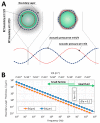Acoustic Manipulation of Bio-Particles at High Frequencies: An Analytical and Simulation Approach
- PMID: 30400480
- PMCID: PMC6190359
- DOI: 10.3390/mi8100290
Acoustic Manipulation of Bio-Particles at High Frequencies: An Analytical and Simulation Approach
Abstract
Manipulation of micro and nano particles in microfluidic devices with high resolution is a challenge especially in bioengineering applications where bio-particles (BPs) are separated or patterned. While acoustic forces have been used to control the position of BPs, its theoretical aspects need further investigation particularly for high-resolution manipulation where the wavelength and particle size are comparable. In this study, we used a finite element method (FEM) to amend analytical calculations of acoustic radiation force (ARF) arising from an imposed standing ultrasound field. First, an acoustic solid interaction (ASI) approach was implemented to calculate the ARF exerted on BPs and resultant deformation induced to them. The results were then used to derive a revised expression for the ARF beyond the small particle assumption. The expression was further assessed in numerical simulations of one- and multi-directional standing acoustic waves (SAWs). Furthermore, a particle tracing scheme was used to investigate the effect of actual ARF on separation and patterning applications under experimentally-relevant conditions. The results demonstrated a significant mismatch between the actual force and previous analytical predictions especially for high frequencies of manipulation. This deviation found to be not only because of the shifted ARF values but also due to the variation in force maps in multidirectional wave propagation. Findings of this work can tackle the simulation limitations for spatiotemporal control of BPs using a high resolution acoustic actuation.
Keywords: acoustic radiation force (ARF); bio-particle; microfluidics; standing acoustic waves (SAW).
Conflict of interest statement
The authors declare no potential conflicts of interest.
Figures






Similar articles
-
Investigation into the Effect of Acoustic Radiation Force and Acoustic Streaming on Particle Patterning in Acoustic Standing Wave Fields.Sensors (Basel). 2017 Jul 19;17(7):1664. doi: 10.3390/s17071664. Sensors (Basel). 2017. PMID: 28753955 Free PMC article.
-
Numerical study of acoustophoretic manipulation of particles in microfluidic channels.Proc Inst Mech Eng H. 2021 Oct;235(10):1163-1174. doi: 10.1177/09544119211024775. Epub 2021 Jun 11. Proc Inst Mech Eng H. 2021. PMID: 34116594
-
Radiation dominated acoustophoresis driven by surface acoustic waves.J Colloid Interface Sci. 2015 Oct 1;455:203-11. doi: 10.1016/j.jcis.2015.05.011. Epub 2015 Jun 3. J Colloid Interface Sci. 2015. PMID: 26070191
-
Surface acoustic wave manipulation of bioparticles.Soft Matter. 2023 Jun 14;19(23):4166-4187. doi: 10.1039/d3sm00457k. Soft Matter. 2023. PMID: 37212436 Review.
-
Production of acoustic radiation force using ultrasound: methods and applications.Expert Rev Med Devices. 2018 Nov;15(11):819-834. doi: 10.1080/17434440.2018.1538782. Epub 2018 Oct 31. Expert Rev Med Devices. 2018. PMID: 30350736 Free PMC article. Review.
Cited by
-
Active PZT Composite Microfluidic Channel for Bioparticle Manipulation.Sensors (Basel). 2019 Apr 29;19(9):2020. doi: 10.3390/s19092020. Sensors (Basel). 2019. PMID: 31035737 Free PMC article.
-
Improved acoustic holograms using simulated annealing.Biomicrofluidics. 2025 Apr 15;19(2):024105. doi: 10.1063/5.0258632. eCollection 2025 Mar. Biomicrofluidics. 2025. PMID: 40242652 Free PMC article.
-
Extracellular Vesicle Preparation and Analysis: A State-of-the-Art Review.Adv Sci (Weinh). 2024 Aug;11(30):e2401069. doi: 10.1002/advs.202401069. Epub 2024 Jun 14. Adv Sci (Weinh). 2024. PMID: 38874129 Free PMC article. Review.
References
-
- Gholizadeh S., Draz M.S., Zarghooni M., Sanati-Nezhad A., Ghavami S., Shafiee H., Akbari M. Microfluidic approaches for isolation, detection, and characterization of extracellular vesicles: Current status and future directions. Biosens. Bioelectron. 2017;91:588–605. doi: 10.1016/j.bios.2016.12.062. - DOI - PMC - PubMed
Grants and funding
LinkOut - more resources
Full Text Sources

